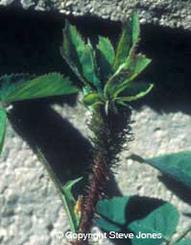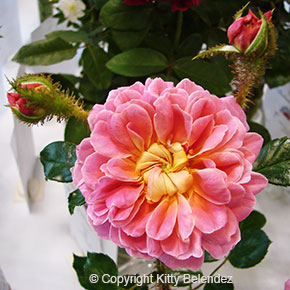About Moss Roses
By H. Scott Hansen
Moss roses are another of the Old Garden Rose classes distinguished by green, mossy-looking growth on the sepals of the bud and the calyx. The "moss" is really small glandular growth which is a mutation of the prickles and oil glands found in most roses. The sepals, going clockwise, have two with moss, one without, one with, and the last of the five without. The two without moss are partially covered by those with moss. This is true with all moss roses. The "moss" in many varieties has a balsam or piny scent especially when touched.
The beginning of the moss roses is generally held to have been around 1700 as a sport of the centifolias. Centifolia Muscosa (Old Pink Moss) is likely the first
and some believe it has never been equalled.
Centifolia Muscosa Alba (White Moss), a sport of the above, is dated 1735. There are about 13 with unknown dates. During the 1840's there were 20 moss rose varieties introduced; during the 1850's there were 32; during the 1860's there were 21; and during the 1870's and 1880's there were 6 each year. Four more moss roses are dated in the 1890's; and a several more have scattered introduction dates from 1905 to 1933. The very last two moss rose introductions are from Ralph Moore, Crested Jewel in 1971 and Dresden Doll in 1975, both pink miniature mosses.
The colors of the 113 moss roses listed in Modern Roses 8 and 9 are:
Some of the latter moss roses are very dark like Nuits de Young commonly called "Old Black" and a possible source of the "Black Rose" myth. There is only one yellow Golden Moss from Pedro Dot in 1930 which is not considered very exciting except for its uniqueness; and there is only one apricot Gabrielle Noyelle from Buatois in 1933. There is one orange-pink (classed pink-blend) Robert Leopold from Buatois in 1930.
The moss roses are as a rule quite fragrant with none listed as having no fragrance. Many of the moss blooms resemble the Centifolias, many petalled and mostly quartered.
The blooms forms are described as:
There is only one listed single, Goethe, a mauve from Lambert in 1911.
The true moss roses descended from Centifolias are only annual blooming. Another type of moss is descended from Autumn Damask with its repeat-blooming quality. These are not true moss roses but do have some of the same characteristics with their "moss" being usually somewhat hard and prickly not soft and prolific; more like tiny stiff hairs.
Crosses of these two types resulted in some recurrency. Listed as recurrent are:
Blanche Moreau, a white from Moreau-Robert in 1880.
Deuil de Paul Fontaine, a purple-red from Fontaine in 1873.
Gabrielle Noyelle, noted above.
Mousseline, a white from Moreau-Roberts in 1881.
Soupert et Notting, a deep pink from Pernet pere in 1874.
Listed as somewhat recurrent are:
Having grown Salet and Alfred de Dalmas for many years I must warn you, don't hold your breath for repeat bloom; maybe it is our climate.
Bloom size of the mosses is described as:
Mossiness descriptions include:
This doesn't give us much to go on because 60% have no mention of "moss" but they must have some.
Other interesting features in moss descriptions:
Besides Ralph Moore's two miniature mosses noted, Little Gem, a deep pink from Wm. Paul in 1880, described as tiny, dwarf and compact growth is likely the first miniature moss.
Gloire des Mousseuses, a pink from Laffay in 1852 may be the the largest moss.
Mousseux du Japon, a purple-pink (mb), undated, may be the most heavily mossed.
Capitaine Basroger, a red from Moreau-Robert in 1890 is almost climbing growth.
There are only two listed climbing mosses: Cumber-land Belle, a pink from Dreer in 1900, a sport of Princess Adelaide, and Red Moss, Climbing, a red from Foote with no date, a sport of Red Moss.
Crested Moss, also known as Cristata and Chapeau de Napoleon, a pink from Vibert in 1826, has been popular through the years and is unique because of the growth on the edges of its sepals that resemble little cockades. It has no "moss" on the calyx.
Besides those noted above, some other moss roses that have come down to us are:
Moss roses enjoyed a period of immense popularity in the 19th century and there are those today who think they are "magic", "wonderful", "astounding", and "just great". Not to step on anyone's toes but my feeling about Moss Roses is more of curiosity than any thing else. If anyone wants to think the moss roses are "magic" that's fine with me.
In 1992, H. Scott Hansen, the author of this article, gave a disk full of his articles to Kitty Belendez with permission to publish them. H. Scott Hansen is now deceased.
© Copyright H. Scott Hansen. All rights reserved.
This article was originally published in "Rose Ecstasy," bulletin of Santa Clarita Valley Rose Society,
Kitty Belendez, Editor.
Photos © Copyright by Kitty Belendez
For questions about Santa Clarita Valley Rose Society, contact:


